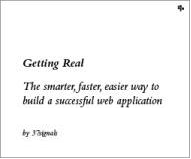I stumbled onto the book Getting Real: The smarter, faster, easier way to build a successful web application while canceling my Backpack service with 37signals. True to the advice they give in the book, 37signals made canceling their service very easy – one of many valuable nuggets of advice offered in the book.
Getting Real describes the practices, both software development and beyond, used by 37signals, a small company that despite their excellent, easy-to-use applications is perhaps still best known as the innovators and driving force behind the Rails framework. Given the tie to the Rails creators, it is not surprising to learn that this book espouses an Agile approach to software development. What differentiates this book from other Agile texts is that it blends both Agile software development practices with, dare I say it, pragmatic guidance from 37signals and other industry notables on the business of creating, releasing and managing Web applications in the Web 2.0 world. This includes advice on staffing and the organization (borrowing from Peopleware), application design (using a user story / UI approach as opposed to a user story / domain object approach), pricing and signup, promotion strategy, support and post-implementation activities.

The book could not have been released at a better time. It will function very well as a handbook for operations at GeoGlue as the team expands. To that extent, I believe you can even purchase an organizational license to the book for about $50. There are a couple of real gems in here (for the Ruby crowd, no pun intended) – one of my favorites is the obligatory sections beating up on functional specifications.
“A bunch of people agreeing on paragraphs of text isn’t true agreement. Everyone may be reading the same thing but they’re thinking something different. This inevitably comes out later on: ‘Wait, that’s not what I had in mind.’ ‘Huh? That’s not how we described it.’ ‘Yes it was and we all agreed upon it – you even signed off on it.’ You know the drill.
Further, I appreciated the analogy between agile approaches and parallel efforts outside of software engineering such as military special operation forces and hurry-up offenses in American football. In this respect, I’m sure functional specifications will continue to have their place, as do conventional forces that constitute the majority of our military and the huddle-based offense run during 95% of your average football game. Getting real is a great approach – but it’s not the only approach.
In the end, I measure a book by how timeless it is and how often I refer to it after my initial reading or perusal. I believe that, in this sense, Getting Real will take a coveted position next to classics by Fowler, the GoF, Stephens, Wall, and others.